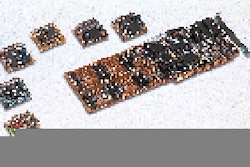
Seattle-based Oceantrawl, Inc. took value-added packaging to a whole new level last summer when it installed horizontal form/fill/seal machines on two of its salmon processing ships. "There's only a handful of players in this business, and we know this has never been done before," says production manager Pat Corbett. Most of Oceantrawl's production is sold to Japanese markets. Like others in the business, Oceantrawl used to process its fish in a more traditional manner: headed, gutted and frozen in 35-lb blocks. "I traveled to Japan to conduct some market research and discovered that roughly 70% of the salmon arriving in Japan was reprocessed," says Oceantrawl vice president Ron Pauley. This involves splitting and salting each fish, vacuum packaging it, and then freezing it again for distribution and sale. Pauley figured, why not handle these steps at sea? So Oceantrawl began to research all the equipment they'd need. First there was processing gear for heading, evisceration, removal of tails and fins, splitting, and brine injection. Then there was packaging equipment. In 1995, this amounted to nothing more elaborate than a small vacuum chamber machine. It produced about 250ꯠ lb that sold so quickly, the firm knew it was time to upgrade. After yet more research, management selected for each of its two salmon processing ships a Model R530 stainless steel vacuum packaging machine from Multivac (Kansas City, MO). The machines arrived at port in Seattle in early June and were loaded on board and operating in one day. On June 15 the ships left port for Bristol Bay, Alaska. They anchored about eight miles off Naknek, where they stayed for the five-week Bristol Bay sockeye salmon run. Before it was over, they were producing about 200ꯠ lb of fish per day in each ship. And even though the machines are only used for about five weeks out of each year, Oceantrawl is plenty happy with its return on the investment. "If you net a dollar per pound more for a value-added package, it doesn't take long to pay off the investment in equipment," says Corbett. "It was pretty amazing, too. We were producing the portions four-up at about 15 cycles/min, so there were plenty of fillets shooting out of those Multivac machines." It couldn't have been a tougher environment, adds Corbett, considering that the machines were outside in the salt-sea air and surrounded constantly by the inherent messiness of a fish processing operation. "The Multivacs turned out to be real work horses," says Corbett.




























